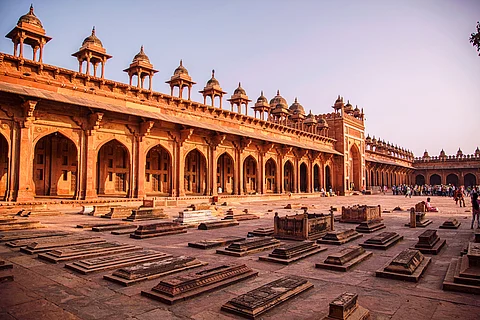
- Destinations
- Experiences
- Stay
- What's new
- Celebrating People
- Responsible Tourism
- CampaignsCampaigns
- SubscribeSubscribe
- Buy Now

If you stay updated with news, you may have read about former British Prime Minister Rishi Sunak's recent visit to Fatehpur Sikri. Accompanied by his wife, daughters, and mother-in-law, Sudha Murty, this excursion was an exploration of one of India's most historically-rich sites.
Fatehpur Sikri was built during the second half of the 16th century by Emperor Akbar. Also known as the City of Victory, it was built as the capital of the Mughal Empire. However, a few years after its completion, Fatehpur Sikri was abandoned, and the capital was moved to Lahore in present-day Pakistan. It is believed that the city was abandoned due to water shortages. Today, Fatehpur Sikri is a UNESCO World Heritage Site and is considered one of the finest examples of Mughal architecture. The complex, located near Agra, features a series of monuments and temples, including one of the largest mosques in India, the Jama Masjid. Architecturally, these buildings represent a stunning blend of indigenous and Persian styles.
Commissioned by Emperor Akbar for his beloved queen Mariam-uz-Zamani (also known as Jodha Bai), the palace is the largest structure in the residential complex. This architectural red sandstone masterpiece showcases a mix of Hindu and Persian styles. It features intricately carved interior pillars, balconies, perforated stone windows, and striking azure-blue ribbed roofs on both the north and south sides.
The Diwan-i-Aam, or public audience hall, served as a venue for various public gatherings, including the Emperor's daily appearances. This hall was also the site for court ceremonies, guest receptions, administration of justice, and the celebration of major festivals and military victories. The Diwan-i-Aam features a quadrangular layout, surrounded by a colonnaded passageway that includes 111 bays.
Diwan-I-Khaas or the Hall of Private Audience is situated in the northeast corner of the complex. At the hall's centre stands a large, intricately carved pillar, which served as the emperor's seat. The diagonal galleries surrounding the pillar were likely designated for meetings with ministers and nobles. Four octagonal kiosks at each corner of the building feature circular domes topped with inverted lotus designs. This structure is believed to have been used for religious discussions, referred to as the Ibadat Khana, or perhaps as a treasury where the emperor would store and inspect his gemstones.
To the south of the court stands the impressive Buland Darwaza, or the Lofty Gate. Reaching a height of 40 m, this monumental structure evokes a sense of immense strength and grandeur, emphasised by the steep flight of stairs leading up to it. Completed in 1575, Buland Darwaza commemorates Mughal victory over Gujarat in 1572. According to UNESCO, it is the most significant monumental structure from Emperor Akbar’s entire reign, and is regarded as one of the finest architectural achievements in India.
Among the religious monuments at Fatehpur Sikri, Jama Masjid is the earliest building constructed on the summit of the ridge, completed between 1571 to 1572. Built around a large courtyard, it was the largest mosque in India at the time of construction. The mosque also incorporates the tomb of Saikh Salim Chishti, which UNESCO describes as "an extraordinary masterpiece of sculpted decoration."
Fatehpur Sikri boasts several other exceptional monuments worth exploring. Among them are the Panch Mahal, a five-storeyed structure made entirely of columns and designed asymmetrically in the style of a Persian badgir; and the wind-catcher tower. Other notable sites include the pavilion of the Turkish Sultana, Anup Talao (the Peerless Pool), the Khwabgah (Sleeping Chamber), the Caravan Sarai, Haram Sara, and the Hiran Tower.
